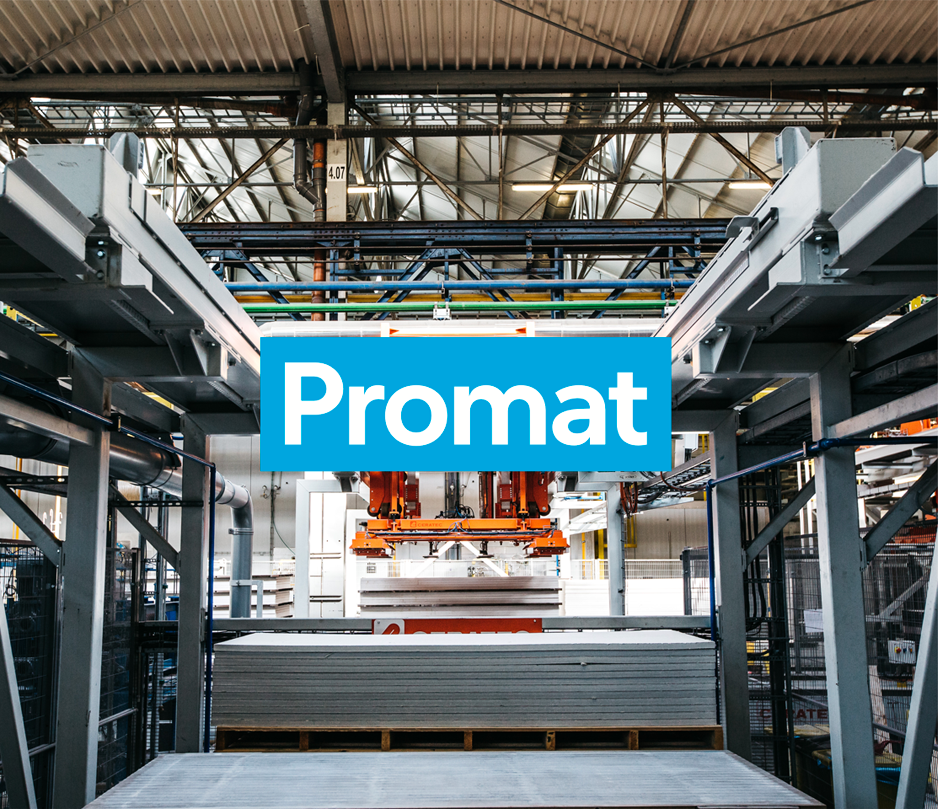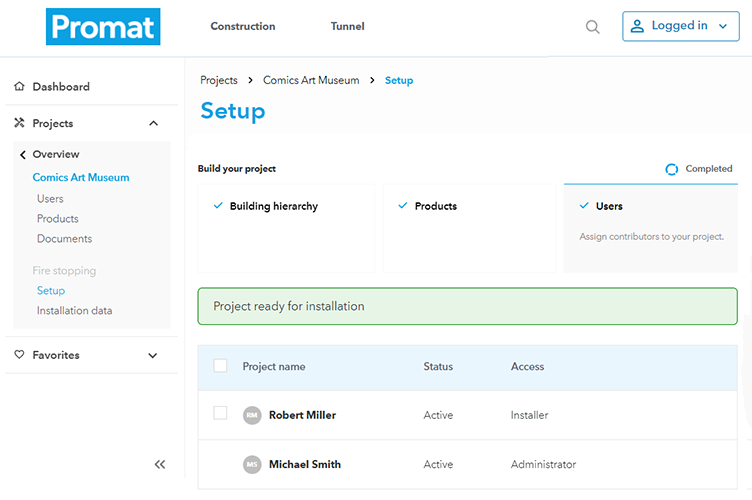Frequently Asked Questions
Do you want to learn more about Passive Fire Protection? Please contact us with all your questions. You might already find some answers here. Not satisfied? Contact your local expert and enter the fascinating world of fire protection.
Generally speaking PROMATECT boards are designed for internal applications and should avoid getting wet. However we do have some boards that can be used in semi-exposed or exposed situation please contact us via our technical enquiry page for further advice on your specific application.
Requirements differ from state to state in terms of the training requirements for installing fire resistant products. But we would recommend that anyone who is installing our products have some training, as there are specific things that need to be done for each installation to ensure that (1) it is compliant and (2) that it will work.
Our fire collars, PROMASEAL® IBS, PROMASEAL® Fyrestrip, PROMASEAL® FlexiWrap and other intumescent based products are produced in our Adelaide manufacturing facility.
Our CAFCO vermiculite sprays are also produced in Australia.
Our boards and sealants are produced by our sister companies in Europe and Asia
For safety data sheets for Promat products please click the following link
A test report or assessment is a valuable document so we as a company have made a decision to not post them directly to our website. Without a proper knowledge or understanding of what the report is saying, incorrect assumptions might be made. So our philosophy is that the test report or assessment is provided with full technical assistance to ensure you have the right report for your application. In the documents section a series of System Certificates for various products and applications will advise what has been tested and the report number that it comes from. To obtain copies of test or assessment reports please contact your nearest office or fill in a technical request and our team will be in contact.
We have distribution centres in Sydney and Adelaide and distributors in Melbourne, Brisbane and Perth.
Our fire collars and other penetration seal products are also available through Reece, Tradelink, Plumbers Supplies Co-op and other plumbing products merchants.
Fire is the ultimate in destructive forces and the sheer amount of damages and fear it can create is amazing. The main consequences of fire are:
Death - this is a very real risk. Fire, and its consequences which are toxic gases and smoke, are extremely dangerous for human being. Every year more than 3000 people are killed by fire in USA and about 4000* in Europe!
Injury - about 10% of all personal injuries reported each year are caused by fire. in Europe 190 people are hospitalized every day with serious fire injuries*.
Building damage - can be very significant, particularly if the building materials have poor fire resistance and there is little or no built-in fire protection. In Europe 126 billion €, or 1% of European GDP* , burned in fire costs yearly. In USA, the situation is even worse, resulting in damages and losses of $329 billion**, or 2.1 percent of the US gross domestic product!
Loss of business and jobs - it is estimated that about 40% of businesses do not start up again after a significant fire. Many small companies often cannot afford the time and expense of setting up again their activities.
Environmental damage - the fire and/or fighting the fire - fire-fighting water, the products of combustion can contaminate significant areas around the fire site.
*FSEU – year 2020 and **NFPA year 2017
An FRL is an abbreviation or acronym for (F)ire (R)esistance (L)evel and it set out in the format similar to this -/60/60. They indicate what period of time a system will resist fire for. The National Construction Code sets out what FRL's are required for various different situations and they will vary depending on the height and class of building that is being used.
Each number is a time period that refers to a an elements ability to resist fire in terms of different requirements. The requirements are structural adequacy (the ability to remain standing), integrity (stopping flame and hot gasses from passing through) and insulation (stopping heat from passing through). For further information on this subject click here
Passive fire protection refers to elements that are far of the structure of the building. These include compartmentation, such as fire resistant walls and ceiling, structural protection of both steel and concrete elements and service protection through service penetration seals or fire resistant ducts or enclosures. These systems are designed to stop a fire spreading from its area of origin and require no further inputs such as power or water for them to do their job. On the other side are the active systems such as sprinklers, hydrants and smoke extraction which use water and other substances to supress the fire itself. The best buildings use a combination of both systems to keep the occupants safe.
The insulation criteria is the third number in an FRL. It relates to stopping heat transfer from a fire affected compartment through a fire rated barrier. It also applies to the services passing through those barriers, so it will often mean that a service such as a metal pipe will require somesort of barrier of wrap to be applied for it to acheive this requriement. More info on this can be found here
Compartment elements can be split in two main groups:
Vertical partitions - Non-loadbearing partition walls are often brick, concrete or lightweight walls such as PROMATECT board or plasterboard. In some cases, the existing walls need to be upgraded to reach the fire resistance rating asked by the local regulation or by the specifier. Even loadbearing walls, such as concrete walls, could need upgrading to increase their fire resistance.
Horizontal compartmentation - A natural horizontal compartmentation is the floor itself. If the floor on its own does not meet the fire resistance criteria, passive fire protection is then needed. The most common horizontal compartmentation systems are:
Concrete Slabs
Membrane ceilings
Suspended ceilings
Combined Floor / Ceiling Systems
To keep a fire, hot smoke and gases where they are by creating boundaries to stop their propagation, leaving enough time for the occupants to escape safely. It is also meant to give time to the fire brigade to enter the building, check if all the occupants have actually left or help those who can't get out on their own, and then fight the fire itself before it spreads to other compartments.
Splitting a building into compartments also means that fire and smoke damage will be limited to the compartment involved in the initial fire, while the rest of the building, and the property it contains, will remain safe.
Even if firestop systems are tested at very high temperature (usually more than 1000°C.), these tests are under fire conditions (so with a growing fire curve up to 2 or even 4 hours maximum) and not day to day constant exposure to high temperatures. Most firestop systems start to react, changing chemically or physically at relatively low temperatures (100 to 200°C), such as the intumescent materials and the endothermic coatings. Therefore, these products cannot be used as “high temperature sealant”.
The Promat Fire Collar range contains a product called Grafitex. This is an intumsecent product which when heated beyond a certain temperature will expand and form an insulating char which stops flames, hot gasses from passing through it and slows the rate at which heat will pass. Where a combustible service such as a plastic pipe is penetrating a fire resistant element this expansion is important as the plastic will melt leaving a hole, so the intumescent material expands and fills up that hole, to ensure that the fire resistant element is not breached.
For any service that penetrates a fire rated element, the Building Code requires that the service penetration maintain the same FRL as the element. There is no minimum size where it is not required. The type of service and element and the required FRL will determine what type of product is used to do the sealing.
The answer to this question is two fold. Firstly the NCC in Clause 3.15 requires that the system used to protect service penetrations is identical to what has been tested. The second part is that AS1530.4 has a specific way of testing for floor waste installations. The placement of the temperature sensors (thermocouples) in the floor waste test is such that the fire collar that is used must be able to close off much more quickly to stop the heat transfer, than in a situation where the pipe continues above the slab. This means that the collars used in this situation generally have a mechanical and an intumsecent component, which assists in closing the collar more quickly.
Although concrete heats up relatively slowly during fire, there are still ways that a concrete element can fail. The most common failure mechanism is when the concrete cover on the steel reinforcement is not thick enough to keep the reinforcement temperature down. This is often the case for old buildings and for buildings with very high fire resistance requirements. Fire protection can compensate for the lack of concrete cover thickness.
However, in cases where concrete is exposed to humid environments and/or potentially more severe fire temperatures, spalling of concrete poses an additional risk. Spalling of concrete causes quick and explosive detachment of layers of the concrete structure, usually occurring in the first 5 to 30 minutes of the fire, even if the temperature is still quite low, and exposing the steel reinforcement directly to the flames. In such cases it is necessary to apply fire protection to make sure that the concrete temperatures remain low and spalling does not occur.
When steel is heated to temperatures of 400°C to 800°C, its strength gradually decreases. The stiffness of steel starts to decreases at 100°C. The reduction in strength and stiffness will cause large deformations and eventually collapse of building elements. As steel structures are generally slender and steel has a high thermal conductivity, they tend to heat up fast when exposed to fire.
By applying a protective shell around the steel element or a fire shield such as a fire-rated suspended ceiling, the heating up of the steel is delayed and collapse can be postponed or avoided.




